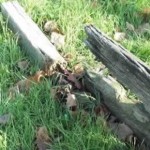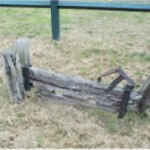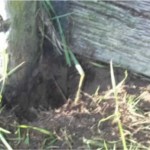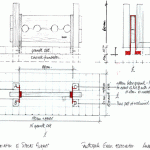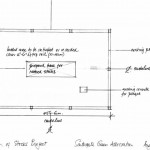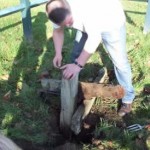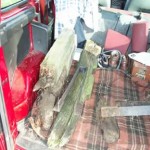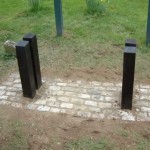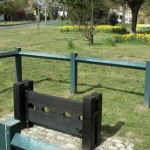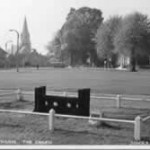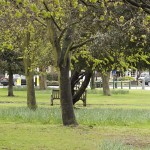 The Stocks were a coronation gift to the Green in 1953 and are a replacement for an earlier set that went missing during the Second World War. Unfortunately although made of oak, whole sections of the stocks have rotted under the impact of many years of weathering. The stocks were in danger of disintegrating before the Southgate Green Association put forward a plan to restore them. This picture shows them in a much better state of repair in the fifties. It also shows the elm and oak trees that were a characteristic of The Green at that time.
The Stocks were a coronation gift to the Green in 1953 and are a replacement for an earlier set that went missing during the Second World War. Unfortunately although made of oak, whole sections of the stocks have rotted under the impact of many years of weathering. The stocks were in danger of disintegrating before the Southgate Green Association put forward a plan to restore them. This picture shows them in a much better state of repair in the fifties. It also shows the elm and oak trees that were a characteristic of The Green at that time.
The stocks are a fascinating reminder of The Green’s long history. Stocks and pillaries have been in use for more than 1000 years. They were used as a punishment from the Middle Ages up to the eighteenth century. In 1405 a law was passed that required every town and village to have a set of stocks, usually placed by the side of a public highway or village green. Stocks were a status symbol for smaller communities. If a town was too small or could not afford stocks that town was regarded as a hamlet and could not call itself a village. The pillory was only abolished in England around 1837. Stocks were never formally abolished and were used until around 1870.
People who were punished with the use of stocks included traveling musicians, fortune tellers, ballad singers, drunkards, gamblers, revilers, Sabbath breakers, vagrants, wife beaters, unruly servants and petty thieves. Some of the more regular occupants of stocks and pillories were shopkeepers and market stallholders who cheated their customers. For example, giving short change or measure, selling poor quality merchandise. The punishment was often made to fit the crime. A butcher who sold rotten meat would be pilloried with the offending product tied around his neck. An alewife who watered down her beer would have it poured over her head while she sat in the stocks. Often the punishment depended on the mood of the mob. Daniel DeFoe, for example, was put in the pillory for satirizing the government. The crowd brought him food and water and showered him with flower petals.
Without necessarily wishing to see the stocks in use again both visitors and local people had noted the deterioration of the Southgate Green stocks with regret.
The restoration project required the approval of Enfield Council and help from a local builder.
Dr. Gandhi researched the appropriate materials for the project and oak and three hundred year old hand wrought nails were purchased. Her account of the traumas of dealing with the various departments concerned is here. The restoration work was carried out by Chris Lack who is a member of the Association. Shaun Rigg liaised with highways contractor Accord Jarvis for sponsorship of the new base on behalf of the Association. Ken and Rebecca Youngman helped with the removal. Our thanks go to all of them for their efforts!
- Plans of the Stocks
